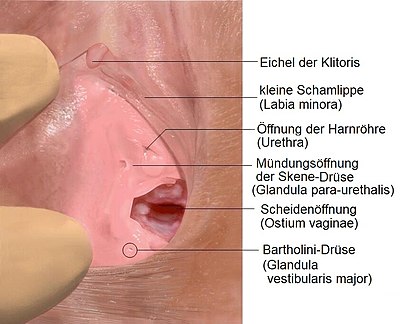Glandula vestibularis major

The glandula vestibularis major (pl. Glandulae vestibulares majores ; lat. "Large [vaginal] atrial gland ", also Bartholin's gland ) is a paired accessory sex gland of women . It opens into the vestibule between the labia minora ( the labia minora ). The name Bartholin gland comes from the Danish anatomist Caspar Bartholin the Elder. J. (1655-1738) back.
When the woman is sexually aroused , the Bartholin's gland secretes a secretion that is used for natural lubrication . The approximately one to two centimeters long ducts open into the vaginal vestibule in the positions of the hands of a clock at “8 and 4 o'clock”.
Equivalence in animals
In addition to the female, this gland is also developed in female ruminants and cats . In the other mammals it does not occur, only the small atrial glands ( glandulae vestibulares minores ) are formed here. Small atrial glands appear in addition to the large ones in women and ruminants; cats only have the large ones. The small atrial glands are collections of glands scattered into the wall of the vaginal vestibule that are invisible to the naked eye.
Correspondence with men
The corresponding gland in the male or male mammal is called the bulbourethral gland ( Glandula bulbourethralis , Cowper's gland ). It is located next to the base of the penis and empties its secretion directly into the urethra.
Diseases

Inflammation of the Bartholin's gland can lead to Bartholinitis , the Bartholin cyst and, in the case of infections by bacteria, usually Escherichia coli , Neisseria gonorrhoeae , Staphylococcus aureus or Chlamydia trachomatis, to an empyema , the Bartholin empyema. Treatment is conservative by administering antibiotics or, if a cyst or empyema develops, by surgical intervention, an incision , the so-called marsupialization of the cyst. Untreated empyema can lead to generalized infection , life-threatening sepsis . The cyst or empyema can be extremely painful.
See also
literature
- Uwe Gille: Female genital organs. In: F.-V. Salomon et al. a. (Ed.): Anatomy for veterinary medicine. Enke, Stuttgart 2004, ISBN 3-8304-1007-7 , pp. 379-389.
Individual evidence
- ^ Herbert Lippert: Textbook anatomy . Elsevier, Urban & Fischer, 2011, ISBN 978-3-437-59376-5 , pp. 425ff (accessed on 29 August 2012).